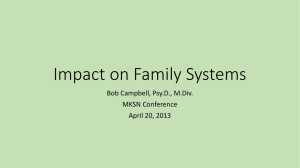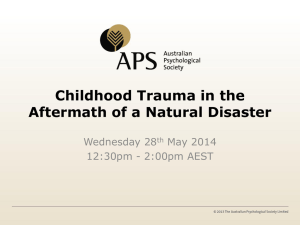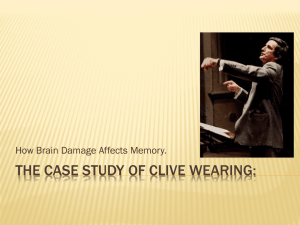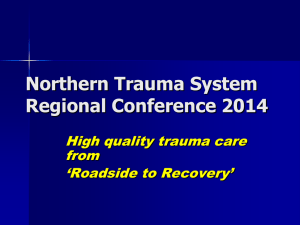Jenny Taylor - SIG presentation for website
advertisement
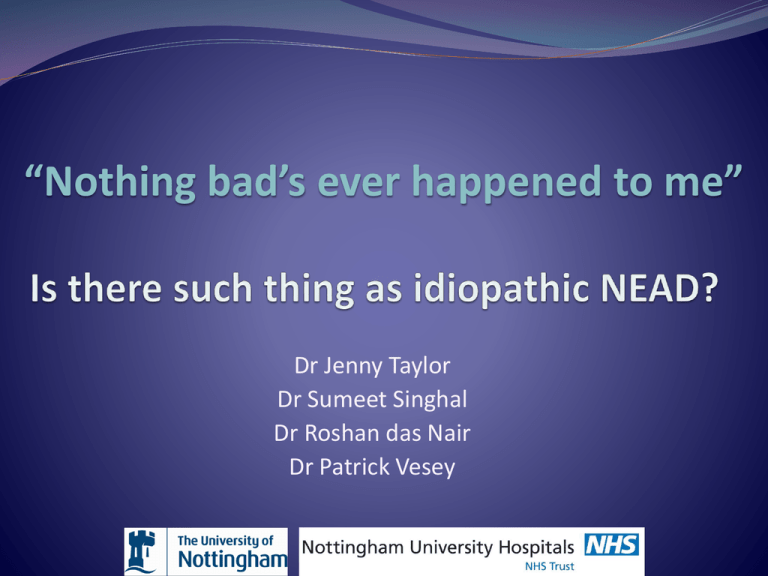
“Nothing bad’s ever happened to me” Dr Jenny Taylor Dr Sumeet Singhal Dr Roshan das Nair Dr Patrick Vesey Aims Background and rationale Methods Results Discussion points Conclusions Clinical Implications Questions Psychogenic non-epileptic seizures Psychogenic non-epileptic seizures (PNES) resemble epileptic seizures, but no abnormal electrical changes in the brain (Bodde, et al., 2009) Incidence: 25-30% of those referred to epilepsy centres (Bodde, et al., 2009) Accepted to be psychological in nature (Lesser, 1996) Higher rates of psychological problems and trauma history (review: Reuber, 2008) Always psychological causality? Maybe not... Absence of psychological comorbidity or trauma history in 3 – 32% of people with PNES (Moore & Baker, 1997; Reuber, et al., 2007; Marchetti, et al., 2008) None of these studies examined the presenting profiles of those without causal factors Why not always causal factors? 1. Absence of trauma/psychological comorbidity? 2. Non-expression? a) Methodological factors, e.g. Underreporting in interviews (Fiszman, et al., 2004) b) Other, e.g. Personality factors Key aim of the current study Why is this important? Treatment of choice is psychological (National Collaborating Centre for Primary Care : Stokes, et al., 2004) Treatment assumes psychological problems/trauma history Invalidating? Ineffective? Methods: Participants Patients diagnosed with PNES by neurologist PNES-trauma (PNES-T): Those reporting trauma history/psychological comorbidity N = 10 PNES-no-trauma (PNES-NT): Those not reporting the above N=9 T = Trauma NT = No-trauma Methods: Measures & Analysis Measures Traumatic Life Events Questionnaire (TLEQ) Trauma Symptom Inventory (TSI) Millon Clinical Multiaxial Inventory III (MCMI-III) Analysis Mann-Whitney U-Tests (between-group differences) Cohen’s d effect sizes (between-group effect sizes) ROC curve analysis (evaluation of classification system) Chi-squared test (gender comparison) T = Trauma NT = No-trauma Traumatic Life Events Questionnaire (TLEQ) Kubany et. al (1995) Natural disaster Motor vehicle accident Other kind of accident Lived/worked/military service in a war zone and exposed to warfare/combat 5. Experienced sudden and unexpected death of a close friend/loved one 6. Loved one survived life-threatening accident/assault/illness 7. Had a life-threatening illness 8. Been robbed/present during robbery involving a weapon 9. Hit/beaten up and badly hurt by a stranger 10. Seen a stranger attack/beat up someone, leading to serious injury/death 11. Threats to kill/seriously harm you 1. 2. 3. 4. T = Trauma NT = No-trauma Traumatic Life Events Questionnaire (TLEQ) Kubany et. al (1995) 12. Physical abuse whilst growing up 13. Witness to domestic violence whilst growing up 14. Subject to domestic violence 15. Sexual abuse from an adult when under 13 16. Sexual abuse from a peer when under 13 17. Sexual abuse when aged 13-18 18. Sexual assault when 18+ 19. Other unwanted sexual attention 20. Victim of stalking 21. Miscarriage 22. Abortion 23. Any other events T = Trauma NT = No-trauma Results: Demographics Group T (n=10) Gender NT (n=9) P value 2 M; 8 F (80% F) 3 M; 6 F (67% F) .51 Age: Mean (SD) 40.7 (10.80) 33.67 (9.26) .13 Time since onset, months: Mean (SD) Time since diagnosis, months: Mean (SD) Time to diagnosis from onset, months: Mean (SD) 77.78 (73.55) 91.89 (65.64) .34 19.8 (10.83) 27.44 (22.33) .72 56.67 (72.76) = 4.7 years 62.56 (67.60) = 5.2 years .67 T = Trauma NT = No-trauma Results: Traumatic Life Events Questionnaire Between-group differences Total number of events experienced: Median (IQR); T = 6.5 (3); NT = 2 (1) Significantly more events in T group (p=0.007; ES=1.00) Amount of distress for most distressing experience: Median (IQR); T = 4.5 (3); NT = 2 (2.5) Difference not statistically significant (p=0.210; ES=0.67) T = Trauma NT = No-trauma Results: Traumatic Life Events Questionnaire Comparison with general population T group: Higher rates of reporting in 14/23 life events: Childhood physical abuse, miscarriage, motor vehicle accidents, sudden death of a friend or loved one, assault, threat of harm, witness to family violence, intimate partner abuse, sexual abuse across the lifespan , sexual harassment, and stalking. NT group: Higher rates of reporting in only 2/23 life events Childhood physical abuse & Miscarriage T = Trauma NT = No-trauma Results: Trauma Symptom Inventory Between-group differences Significantly higher levels in T group than NT group on the following scales: Anger/Irritability (p=0.008; ES=1.18) Intrusive experiences (p=0.004; ES=1.25) Defensive avoidance (p=0.001; ES=1.59) Sexual concerns (p=0.040; ES=0.86) Tension reduction behaviour (p=0.040; ES=0.86) T = Trauma NT = No-trauma Results: Trauma Symptom Inventory Comparison with general population T group: Scored higher on all 11 subscales NT group: Scored higher on only 3/11 subscales: Sexual concerns, Dysfunctional sexual behaviour and Tension reduction behaviour T = Trauma NT = No-trauma Results: Millon Clinical Multiaxial Inventory–III Between-group differences: Modifying Indices Significantly higher levels of Debasement (tendency to describe oneself in pathological terms) in the T group (p=0.050; ES=0.90) Significantly lower levels of Disclosure (tendency towards being defensive and secretive in their answering) in the NT group (p=0.014; ES=1.18) T = Trauma NT = No-trauma Results: Millon Clinical Multiaxial Inventory–III Between-group differences: Clinical & Personality Scales Significantly higher scores in the T than the NT group on the following scales: Personality Patterns (Axis II disorders): NB however: Depressive (p=0.006; ES=1.21) levels of Sadistic/Aggressive (p=0.003; ES=1.31) Disclosure and Masochistic/Self-defeating (p=0.050; ES=0.99) Debasement Clinical Syndromes (Axis I disorders): Anxiety (p=0.006; ES=1.26) PTSD (p=0.002; ES=1.43) T = Trauma NT = No-trauma Results: Millon Clinical Multiaxial Inventory–III Comparison with general population T group: Modifying indices: Higher Disclosure and Debasement; lower Desirability Clinical/Personality scales: Higher on 8/18 scales (Avoidant, Depressive, Dependent, Negativistic/ Passive-Aggressive, Masochistic/Self-Defeating, Anxiety, Dysthymia, PTSD); PLUS 3/3 Severe Personality Pathology, 3/3 Severe Clinical Syndrome scales Lower on Histrionic and Narcissistic NT group: Modifying indices: Higher Debasement; similar Disclosure and Desirability Clinical/Personality scales: Higher on Somatoform, Thought Disorder and Major Depression T = Trauma NT = No-trauma Results: ROC curve analysis Conducted for TLEQ to evaluate consistency of neurologist classification system with TLEQ Based on analysis: >4.5 life events T group <4.5 life events NT group 16 out of 19 participants (84.2%) were classified in the same way by both the neurologist and the questionnaire data T = Trauma NT = No-trauma Summary of results T group reported twice as many traumatic life events as NT group and a trend to more distress (ns) T group reported greater Axis I and II pathology than NT group T group reported more trauma and psychological pathology than the general population NT group similar to general population T = Trauma NT = No-trauma Discussion: Why the differences? 1. Truly idiopathic NEAD group? 2. Clinical questioning nor questionnaires sufficiently sensitive? 3. NT group misdiagnosed as NEAD? 4. T group over-exaggerating experiences as traumatic and over-exaggerating psychological comorbidity? 5. NT group under-reporting? T = Trauma NT = No-trauma Conclusions Group differences remained following structured and more anonymous questioning Supports ‘different’ groups, and NEAD causes being more heterogenous than previously suspected However, if proven, the Disclosure differences could explain why groups appear different, but are not Worthy of sufficiently powered formal study T = Trauma NT = No-trauma Clinical Implications Utility of self-report measures Possible limitations of self-report measures (disclosure?) Utility of individual psychological formulation T = Trauma NT = No-trauma Questions? T = Trauma NT = No-trauma References (1) Bodde, N. M., Brooks, J. L., Baker, G. A., Boon, P. A., Hendriksen, J. G., Mulder, O. G., et al. (2009). Psychogenic non-epileptic seizures--definition, etiology, treatment and prognostic issues: a critical review. Seizure, 18(8), 543-553. Braun, V., & Clarke, V. (2006). Using thematic analysis in psychology. Qualitative research in psychology, 3(2), 77-101. Briere, J. (1995). Trauma symptom inventory. Odessa, FL: Psychological Assessment Resources. Brown, R. J. (2004). Psychological mechanisms of medically unexplained symptoms: an integrative conceptual model. Psychological Bulletin, 130(5), 793-812. Coolican, H. (2009). Research Methods and Statistics in Psychology (5th ed.). London: Hodder Education. References (2) Fiszman, A., Alves-Leon, S. V., Nunes, R. G., D'Andrea, I., & Figueira, I. (2004). Traumatic events and posttraumatic stress disorder in patients with psychogenic nonepileptic seizures: a critical review. Epilepsy Behav, 5(6), 818-825. Howlett, S., Grunewald, R. A., Khan, A., & Reuber, M. (2007). Engagement in psychological treatment for functional neurological symptoms - Barriers and solutions. Psychotherapy, 44(3), 354-360. Kubany, E. S. (1995). The Traumatic Life Events Questionnaire (TLEQ): A brief measure of prior trauma exposure. Unpublished scale. Available from the author. Lesser, R. P. (1996). Psychogenic seizures. Neurology, 46(6), 1499-1507. Marchetti, R. L., Kurcgant, D., Neto, J. G., von Bismark, M. A., Marchetti, L. B., & Fiore, L. A. (2008). Psychiatric diagnoses of patients with psychogenic non-epileptic seizures. Seizure, 17(3), 247-253. References (3) Millon, T., & Davis, R. (1996). The Millon Clinical Multiaxial Inventory-Ill. Major Psychological Assessment Instruments, 108. Moore, P. M., & Baker, G. A. (1997). Non-epileptic attack disorder: a psychological perspective. Seizure, 6(6), 429-434. Reuber, M. (2008). Psychogenic nonepileptic seizures: answers and questions. Epilepsy & Behaviour, 12(4), 622-635. Reuber, M., Howlett, S., Khan, A., & Grunewald, R. A. (2007). Non-epileptic seizures and other functional neurological symptoms: Predisposing, precipitating, and perpetuating factors. Psychosomatics: Journal of Consultation Liaison Psychiatry, 48(3), 230-238. Stokes, T., Shaw, E. J., Juarez-Garcia, A., Camosso-Stefinovic, J., & Baker, R. (2004). Clinical Guidelines and Evidence Review for the Epilepsies: diagnosis and management in adults and children in primary and secondary care. London: Royal College of General Practitioners.


